Dubbing has become a crucial tool for making content accessible across different cultures and languages. German, as a widely spoken language in Europe and beyond, is a prime target for localization to reach a larger audience. Whether you’re creating promotional content, translating podcasts like Zeit Verbrechen (Time Crimes), or localizing popular shows like major studios, such as ARD, ZDF, and RTL do, dubbing in German can expand your reach in Germany, Austria, Switzerland, and other German-speaking regions. This guide will cover everything from traditional dubbing methods to cutting-edge German AI voice generators.
What is German Dubbing?
German dubbing process goes beyond simple translation; it’s an art form that requires precise synchronization with the visual elements and lip movements while capturing the tone and emotion of the original content. German audiences have a high standard for dubbing, largely due to the country’s long history of professional voice acting. For instance, many American actors are associated with German dubbing voices that bring their characters to life for German viewers, creating familiarity over time. Unlike subtitles, dubbing goes beyond word-for-word translation, capturing cultural and linguistic nuances unique to German, such as formal and informal pronoun usage (“Sie” vs. “du”) and regional expressions that make the content feel natural and engaging for German audiences.
German Dubbing Options: Traditional vs. AI Video Dubbing
To effectively reach German-speaking audiences, selecting the right voice dubbing approach is essential. There are two main options: traditional German dubbing using voice actors and AI-driven automated dubbing. Understanding the strengths of each method can help choose the best fit for your project, so let’s explore:
Traditional German Dubbing
Traditional dubbing involves hiring professional German voice actors who translate videos and bring their expertise in regional dialects and cultural nuances. For example, Thomas Danneberg is famously known for dubbing both Arnold Schwarzenegger and Sylvester Stallone. However, with traditional dubbing it is essential to find voice actors for the right dialect. For instance, dubbing for a Swiss audience might adjust for Swiss German expressions, while dubbing for German audiences may require adjusting for the neutral High German accent used broadly in media. This method can be time-intensive and costly due to the need for specialized voice talent, directors, and post-production processes to ensure lip-sync accuracy.
AI-Powered German Dubbing
AI-powered German dubbing leverages machine learning and text to speech (TTS) technology to generate natural-sounding voices in German. These AI voices can match the emotional tone and rhythm of spoken German, creating an authentic experience for viewers. One of the major advantages of AI translation is the ability to automate variations in dialect, such as using “Kühlschrank” for “fridge” in Germany versus “Eiskasten” in Austria, as well as accommodate pronunciation subtleties between Swiss, Austrian, and standard German, which can be particularly helpful for brands targeting specific markets within the German-speaking world.
How to Dub a German Video Using AI Voices with Speechify Studio
Speechify Studio is a simple way to create German-dubbed videos with the help of artificial intelligence, Here’s a step-by-step guide for using Speechify Studio to generate lifelike AI voice overs for your video content:
Start a New Project: Select “start a new project” and then choose “dubbing.”
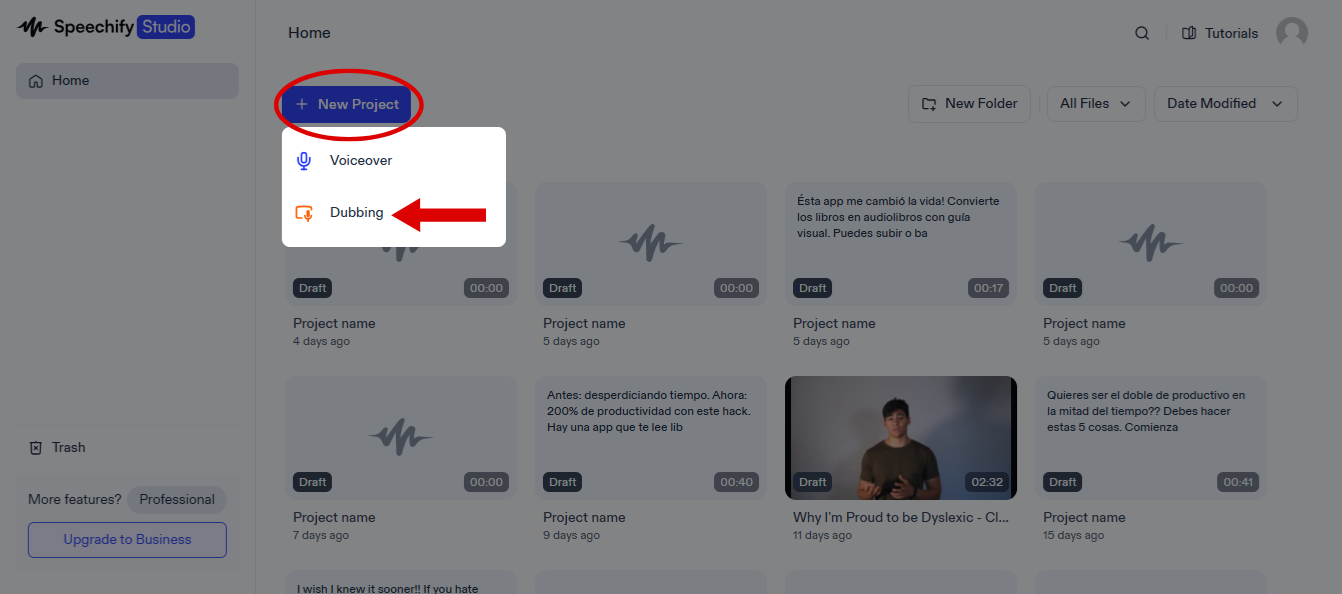
Upload Your Video: Upload the video file format to Speechify Studio, select the number of speakers, and choose the original language. You can also choose to remove filler words or adjust pauses if needed, then click “submit.”
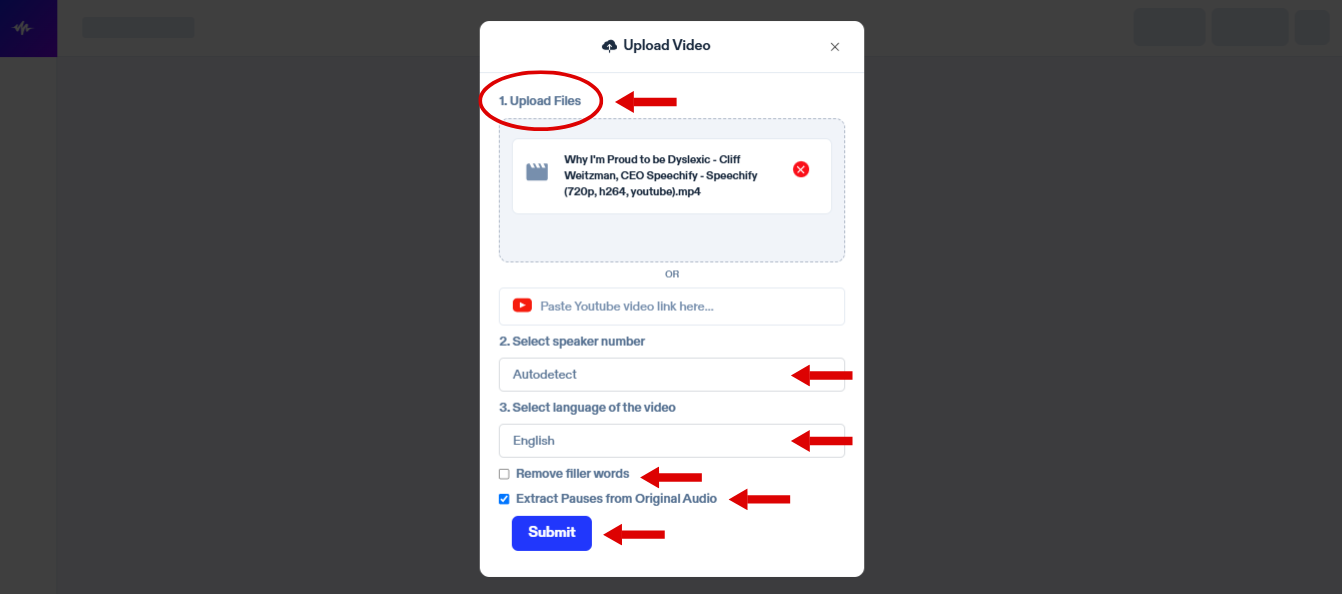
Transcribe the Audio: The platform will automatically transcribe the audio into text. You can then modify the transcription as needed.
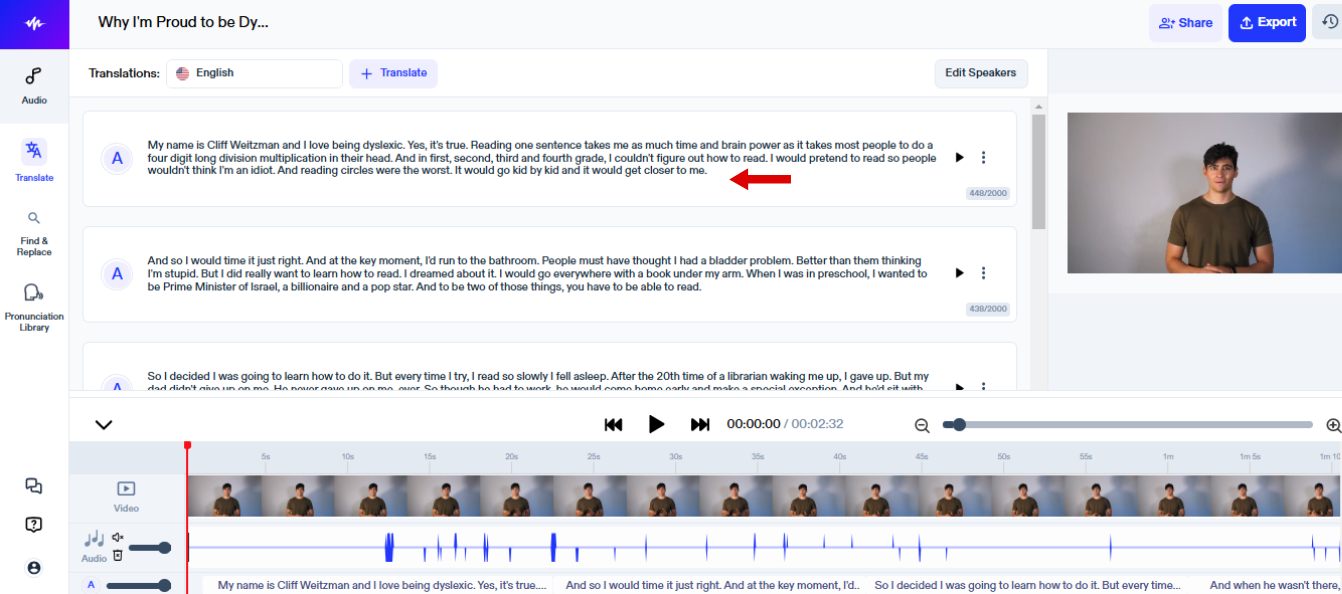
Select German as the Target Language: Tap “translate” and select the appropriate German dialect for dubbing, such as standard German, Swiss German, or Austrian German.
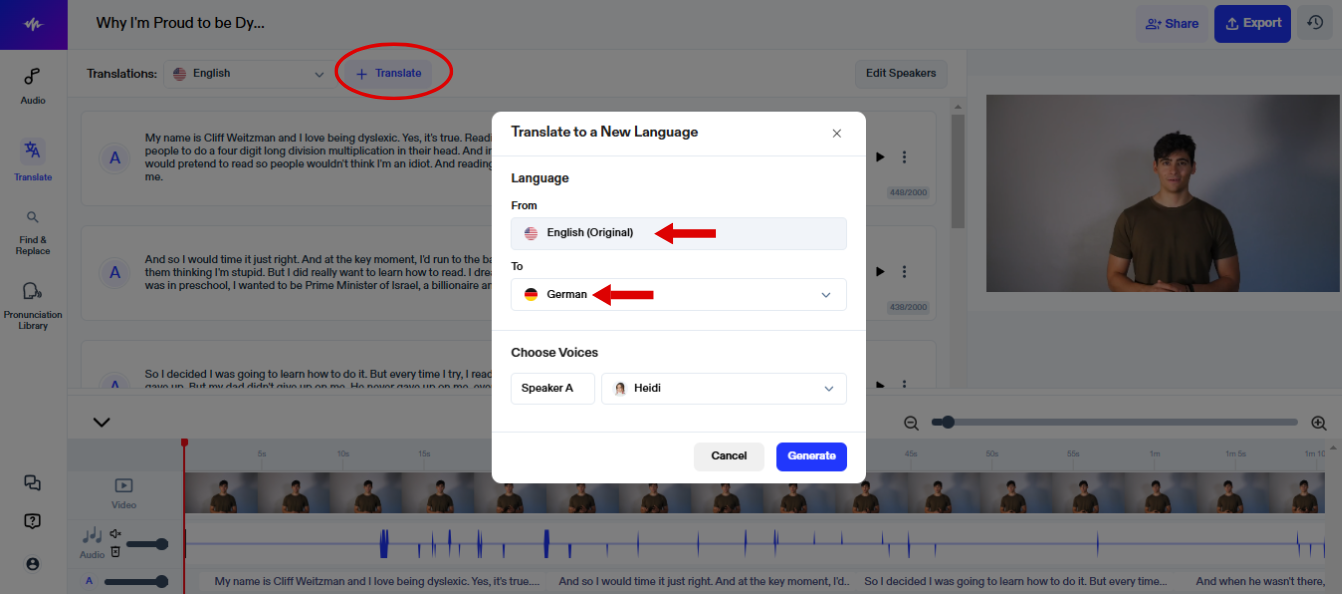
Pick a German Voice: Choose from a range of natural-sounding German AI voices for each speaker.
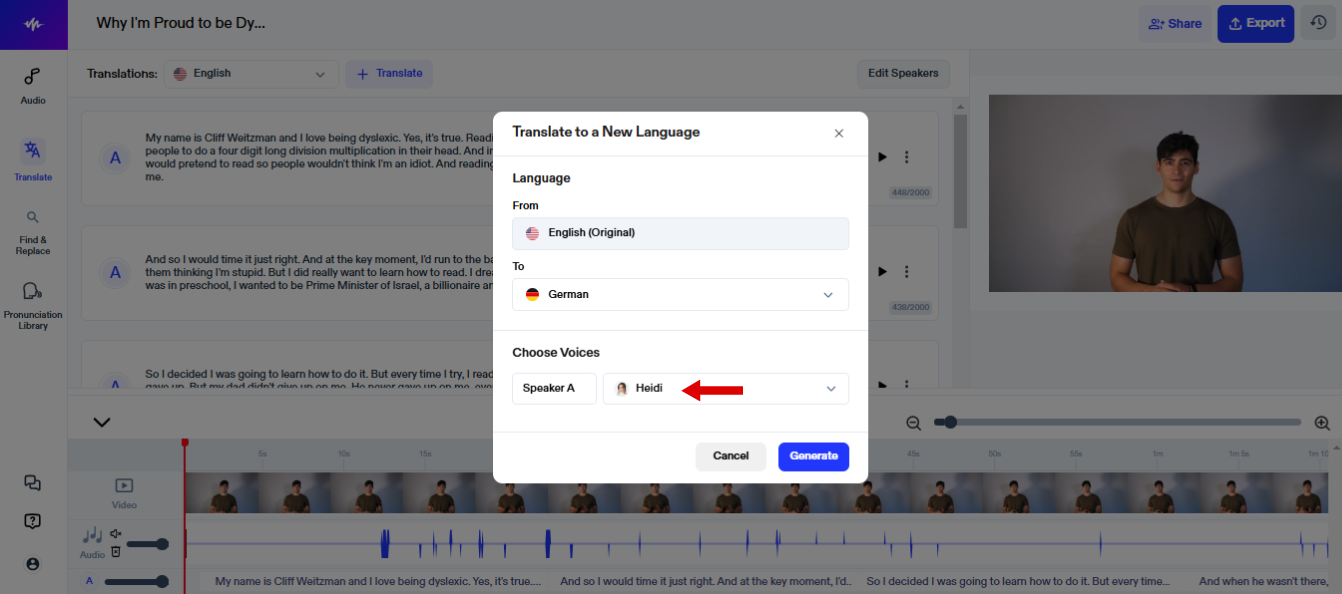
Dub Your Video: Click “generate,” and Speechify Studio’s AI tools will automatically translate and dub your video in German with lip-synching that matches the original.
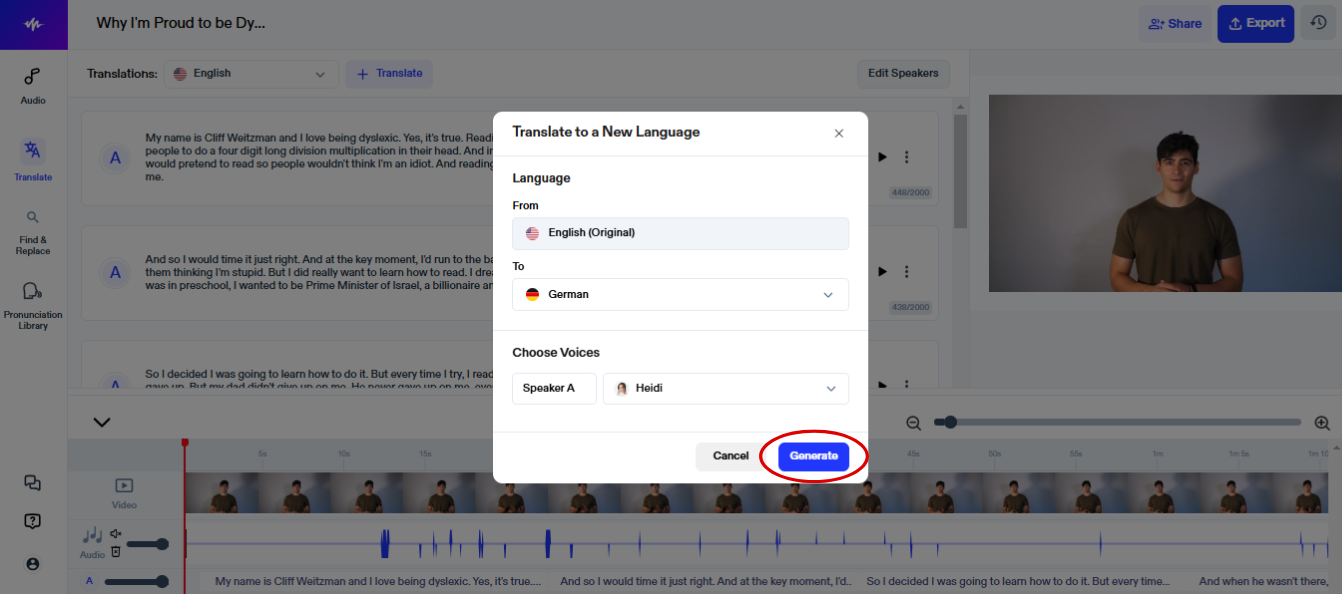
Download the Final Video: Once complete, select “export” to download the newly dubbed video.
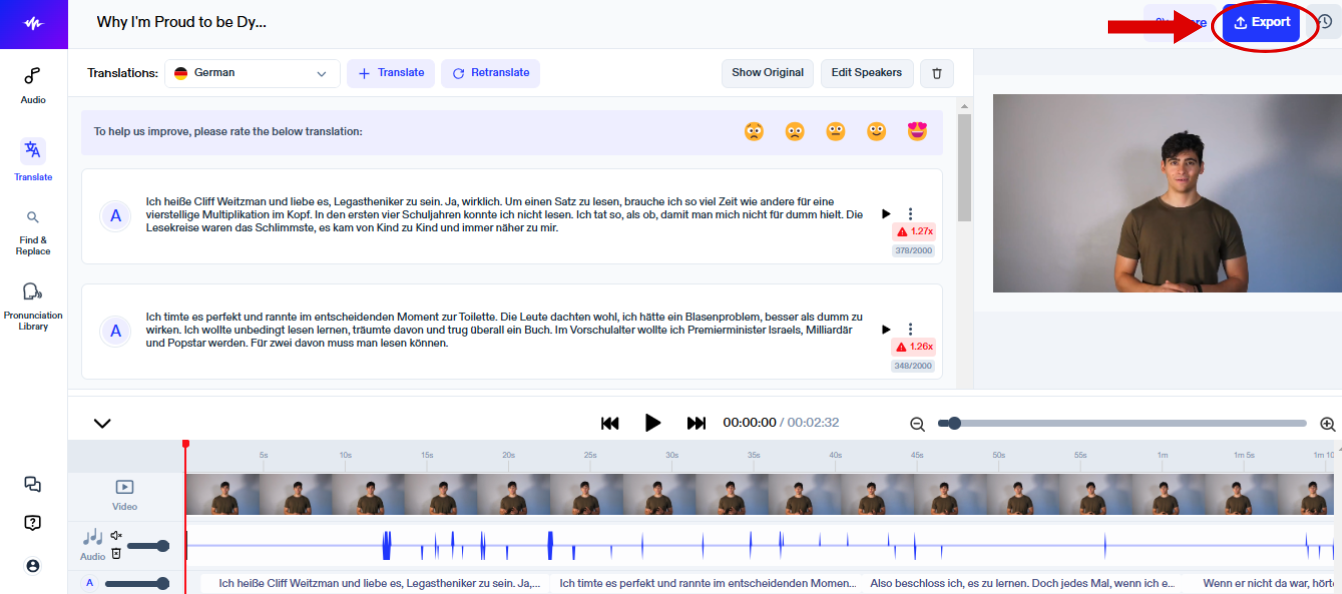
Speechify Studio’s German AI Voice Generator
Speechify Studio’s German AI voice generator provides one of the best AI dubbing tools, with a focus on delivering authentic, linguistically accurate German dubs. Some of its advanced features include:
- Extensive library of AI voices: With over 200 text to speech AI voices in various different languages and accents, including German, Spanish, English, Hindi, Japanese, Arabic, Korean, Russian, Ukrainian, Finnish, Swedish, Turkish, Portuguese, Italian, French, and Chinese, Speechify Studio offers highly realistic options.
- Regional German accents: Speechify Studio supports accents and dialects found in Germany, Austria, and Switzerland, ensuring cultural accuracy for each audience.
- Voice cloning technology: Speechify Studio also offers voice cloning, allowing you to replicate your own voice for consistency in dubbed content across multiple languages.
- Granular control over pronunciation: Users can adjust pronunciation and pacing on a line-by-line basis for added accuracy.
- Emotion and tone adjustments: With Speechify Studio, users can fine-tune the German AI voices by adjusting pitch, tone, and speed for a more personalized performance.
- Context-aware translations: Speechify Studio recognizes context, distinguishing between formal and informal language and adjusting pronouns like “du” (informal you) versus “Sie” (formal you).
- Lip-syncing and synchronization: The platform’s advanced lip-syncing capabilities ensure seamless alignment with mouth movements, even for longer German phrases.
- Multi-speaker support: German dubbing is supported for multiple speakers, distinguishing voices and adjusting for individual dialect nuances. For example, one character can be assigned Swiss German and another character can have an Austrian German accent.
Benefits of German Dubbing with AI
German AI dubbing offers several key benefits for content creators and businesses:
- Cost-effectiveness: AI dubbing reduces the need for extensive studio time and professional voice actors, making it more affordable for smaller companies or social media and YouTube videos.
- Speed: AI-generated German male and female voices can be produced in hours rather than weeks, ideal for companies looking to release content quickly.
- Consistency: AI dubbing ensures uniform voice quality across all German content, making it easy for brands to maintain a consistent voice.
- Localization: German AI voices can be tailored to reflect specific regional dialects or accents. For example, AI-powered dubbing automates specific regional adjustments, such as using “Schokolade” for chocolate in Germany versus “Couverture” in Switzerland.
AI Dubbing: Text to Speech German AI Voices vs. Voice Cloning
When it comes to AI dubbing in German and breaking language barriers, creators can choose between two primary methods: Text to speech (TTS) and voice cloning. Here is a brief break down of both:
German Text to Speech Voices
German TTS voices provide creators with a way to transform written German scripts into natural-sounding speech without the need for professional voice actors. Speechify Studio offers text to speech voices that capture the distinct pronunciation and melodic cadence of German, incorporating subtleties like the use of “ich” vs. “sch” sounds or regional intonations. This can be especially useful for German-speaking audiences on platforms like YouTube or TikTok, where viewers expect accurate, authentic pronunciation.
German Voice Cloning
With German voice cloning, AI technology can replicate specific German voices, allowing companies to use the same voice across different projects. This technique is particularly valuable for brands or well-known content creators and actors such as Julien Bam and Matthias Schweighöfer who want to create a familiar and trusted voice for their German audience. Imagine a German automotive company using AI to clone the voice of their long-time spokesperson; this would provide continuity across advertising campaigns while maintaining a personal touch.
Speechify Studio Understands German
Speechify Studio’s German AI voice generator doesn’t just translate and dub content into German; it truly grasps the linguistic diversity within the language, ensuring natural, high-quality German voice overs and dubs. Here’s a closer look at how Speechify Studio handles the unique nuances across various German-speaking regions to achieve the best possible results:
Pronunciation
Speechify Studio recognizes that pronunciation varies across German-speaking regions, allowing it to adapt to these subtle differences:
- Germany (Standard German): Standard German, or Hochdeutsch, is often spoken in formal settings and in media across Germany. It’s known for clear, crisp pronunciation. For example, words like “ich” (I) feature the standard “ch” sound, while the rolled “r” is common in many regions. Speechify Studio adjusts these details to match local German expectations, making it ideal for content aimed at a German audience.
- Switzerland (Swiss German): Swiss German, or Schweizerdeutsch, has a unique pronunciation and vocabulary that set it apart from Standard German. Words are often softer and spoken with a distinct regional intonation. For instance, the “ch” sound in “ich” can be guttural, more like “ich” in Scottish “loch.” Speechify Studio adapts these sounds for Swiss audiences to maintain authenticity.
- Austria (Austrian German): Austrian German has its own set of sounds, including softer “r” and specific vowel changes that can be distinctive to the Austrian dialect. Words like “Küche” (kitchen) may be pronounced with a rounded “ü” sound that differs from the German pronunciation. Speechify Studio makes sure these regional sounds are captured accurately.
Vocabulary Differences
Beyond pronunciation, Speechify Studio also customizes vocabulary to match regional differences, preserving cultural and linguistic sensitivity across German dialects:
- Bread roll: Known as Brötchen in Germany, Semmel in Austria, and Weggli in Switzerland, this everyday term shifts meaning across regions, and Speechify Studio makes these adjustments seamlessly.
- Potato: Germans typically say Kartoffel, whereas Austrians might say Erdapfel (earth apple), and Swiss speakers may opt for Härdöpfel. This regional vocabulary is adapted depending on the target dialect.
- Grocery bag: In Germany, it’s common to hear Tüte, while Austrians might use Sackerl. Speechify Studio adapts to these regional terms to ensure the content sounds natural and relatable.
Grammatical Differences
Speechify Studio’s advanced AI also understands regional grammatical differences across German dialects, enhancing both accuracy and relevance:
- Pronouns and formality: Speechify adapts between formal “Sie” and informal “du” based on regional context and target audience, essential in German-speaking countries where formality is highly contextual. In Swiss German, there’s more informal “du” usage even in professional settings, which Speechify Studio accounts for to keep the tone appropriate.
- Plural forms: In Swiss German, plural forms often differ, with articles and noun forms being unique compared to Standard German. Speechify Studio ensures these forms are used where necessary, allowing for a smoother and more regionally accurate translation.
- Verb conjugation and tenses: Speechify Studio adjusts verb conjugations for each dialect’s tendencies. For example, in Swiss German, it might avoid certain verb endings that are standard in Germany. This attention to detail helps maintain authenticity in the dub, especially for conversational content.
Diminutives and Expressions
German dialects use diminutives differently, and Speechify understands these regional preferences to match the intended tone:
- Diminutives: While diminutives like -chen (e.g., Mädchen for girl) are common across German-speaking regions, Austrian German also uses -erl (e.g., Braterl for roast). Speechify Studio adapts these variations to fit regional styles.
- Expressions and idioms: German idiomatic expressions vary significantly by region. In Switzerland, you might hear uf Wiederluege for “goodbye,” while Germany uses auf Wiedersehen. Speechify Studio’s German video translator integrates these expressions based on regional context, ensuring an authentic experience for the audience.
Speechify Studio Use Cases for German AI Dubbing
By accurately capturing distinctions across dialects and regions, Speechify Studio’s German AI voice generator is a versatile and effective tool for dubbing content in German. Its advanced capabilities ensure culturally resonant, professional-sounding German dubs that are perfectly suited to reach diverse German-speaking audiences across Germany, Switzerland, Austria, and beyond. Here are just a few of Speechify Studio’s use cases:
AI Voices for German Podcasts
The German podcast market has seen significant growth, with platforms like Spotify Deutschland and Apple Podcasts Germany showcasing thousands of shows. Companies like Audio Alliance, which produces content for ProSiebenSat.1 and RTL Deutschland, can explore AI dubbing to efficiently translate international podcasts for German audiences. For example, science podcasts from English-speaking institutions can be quickly localized using German AI voices, making knowledge more accessible to German listeners.
AI Voices for German Social Media
German companies like Deutsche Telekom and Volkswagen can use AI voices for their social media content, allowing them to create multiple versions of advertisements and promotional videos in different German dialects. Content creators focusing on German lifestyle, tech reviews, and cultural topics, such as Carina Spoon, ViktoriaSarina, and AnKat, can also use German AI voices to maintain consistent posting schedules while delivering content in both High German (Hochdeutsch) and regional dialects.
AI Voices for German Multilingual Marketing Campaigns
International brands entering the German market utilize AI voices for localized marketing campaigns. Companies like BMW and Mercedes-Benz can use AI dubbing to create consistent brand voices across multiple platforms and markets. This is particularly useful for e-commerce platforms operating in German-speaking regions (Germany, Austria, Switzerland), allowing them to maintain brand consistency while adapting to regional linguistic preferences.
AI Voices for German Audiobooks
The German audiobook market, led by platforms like Audible Deutschland and BookBeat, has embraced German AI voices for various content types. German audiobooks, particularly popular genres like historical fiction and mystery novels, or even international bestsellers and German classics like Der Vorleser (The Reader) can be brought to life using AI-dubbed German voices.
AI Voices for German Entertainment
From blockbuster movies to streaming series, German AI voices offer a practical solution for dubbing content in German. German audiences have long favored dubbed films, and Speechify Studio’s German voices provide a cost-effective way for companies like ARD, ZDF, Amazon Prime Video to localize their content and release German-dubbed versions alongside international launches.
AI Voices for German Educational Content
Educational platforms like Coursera and LinkedIn Learning can use Speechify Studio’s German AI voices to provide courses tailored to German students. For example, a course on German philosophy discussing figures like Nietzsche or Kant would benefit from an authentic-sounding German voice, making content accessible and culturally relevant. This technology has also proven especially valuable for creating educational content for German as a second language (Deutsch als Fremdsprache) programs.
AI Voices for German Video Games
Companies like Crytek and GameForge can use German AI voices for various gaming applications. This technology is particularly useful for indie game developers who need to localize their video games for the German market. Mobile game developers use German AI voices to create German versions of their games, while larger studios might use them for secondary characters or procedurally generated content. The technology also helps in creating prototypes and test versions before final voice actor recordings.
AI Voices for German Accessibility
AI dubbing also supports accessibility by providing German audio descriptions and closed captioning for those with vision or hearing impairments. Public broadcasters and streaming platforms are required by law to provide accessible content, making German AI voices a valuable tool. Organizations like the German Federation of the Blind and Partially Sighted (DBSV) can use AI voices to written content accessible. Transportation companies can also use AI voices for announcements in multiple languages, ensuring accessibility for both German speakers and international visitors.
Competitors to Speechify Studio with German AI Voice Capabilities
Speechify Studio stands out as a top AI dubbing tool, but several other platforms also deliver exceptional German AI voice generation. Here’s a closer look at Speechify Studio and some key competitors offering German AI voice options:
Speechify Studio
Speechify Studio supports over 150 languages and accents, including various German AI voices, making it a comprehensive solution for professional dubbing and video editing. It captures emotion, timing, tone, and unique vocal characteristics, delivering realistic and expressive audio. With features like multi-speaker support, auto-subtitling, extensive media library access, advanced voice cloning, and lifelike text to speech, Speechify Studio is perfect for complex projects, from corporate training to creative media.
ElevenLabs
ElevenLabs emphasizes intuitive editing, supporting 29 languages and maintaining the original speaker’s emotional tone, timing, and intent. Known for its natural-sounding German AI voices, it supports multi-speaker dubbing and voice cloning, making it a top choice for content creators, marketers, and educational media developers needing versatile German AI voices.
Rask
Focused on cinematic and high-quality visual projects, Rask supports 135 languages with advanced features like voice cloning, multi-speaker options, and precise lip-syncing. Ideal for German filmmakers and video editors who prioritize professional-grade voice integration, Rask preserves speaker characteristics and ensures synchronization with visuals, making it well-suited for film, documentaries, and creative storytelling.
Murf
Murf specializes in emotional depth and vocal fidelity, supporting over 20 languages with a focus on tone, style, and nuance. Featuring German voice cloning and expressive text to speech, Murf is ideal for projects needing nuanced voice overs, particularly in advertising, narration, and podcasting. It’s a valuable asset for professionals aiming to convey authenticity in audio production.
DupDub
With support for over 70 languages and diverse accents, DupDub offers German dubbing with auto-subtitles, multi-speaker capabilities, and lip-syncing, ensuring style and intent are preserved. Its features make it a great choice for those prioritizing accuracy in voice cloning, making it well-suited for e-learning, corporate training, and localization requiring clear German voice overs.
Dubverse
Dubverse covers over 60 languages, providing auto-subtitling, contextual translations, and lip-syncing for precise linguistic adaptation. With flexible German pronunciation and tonal variation, Dubverse is versatile for marketers, content creators, and businesses in multilingual markets, offering adaptive voice cloning and text to speech for effective localized content.
Wavel
Covering over 70 languages, Wavel offers multi-speaker support, synchronization features, and AI-powered voice cloning with up to 95% accuracy in tone and timing. This makes it a strong option for German projects requiring vocal precision, such as training programs, instructional videos, and documentaries.
InVideo
With support for over 50 languages and accents, InVideo provides a collaborative platform with multiplayer editing and access to a library of 16 million stock media files. Its German voice cloning and text to speech capabilities make it ideal for large-scale corporate, marketing, and educational projects, offering teams a centralized solution for media assets and advanced voice over features.
Embracing the Future of German Dubbing with AI
AI-powered German dubbing is revolutionizing content creation, offering German creators and global brands alike a practical solution to meet the high expectations of German-speaking audiences. With Speechify Studio, German localization becomes seamless, efficient, and culturally resonant, allowing for real-time release of dubbed content in German. Whether a company is launching a new series, producing an audiobook, or marketing a product, AI voice generation for German dubbing offers the precision and authenticity German viewers value.
FAQ
How can I dub a German video with AI?
With Speechify Studio, you can easily dub a German video using AI by selecting your desired language and voice options for seamless translation and narration.
How can I use AI to dub a video in German?
To dub a video in German using AI, Speechify Studio offers advanced German voice options that provide natural-sounding and precise audio.
How do I dub a voice over video?
Speechify Studio simplifies dubbing a voice over video by allowing you to choose from a range of voices and synchronize them with your visuals effortlessly.
What is the process for using AI voices to dub a video in German?
The process of dubbing a video in German with AI in Speechify Studio involves selecting German AI voices and fine-tuning for accurate timing and expression after automatic syncing with the original audio.
How do I translate an English video to German?
Speechify Studio enables you to translate an English video to German by providing AI-powered translation and voice dubbing for a fluent and engaging output.





